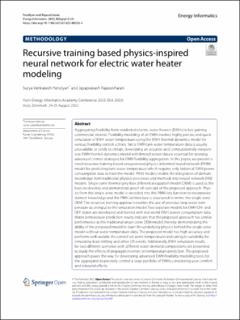| dc.contributor.author | Pandiyan, Surya Venkatesh | |
| dc.contributor.author | Rajasekharan, Jayaprakash | |
| dc.date.accessioned | 2023-02-23T07:40:05Z | |
| dc.date.available | 2023-02-23T07:40:05Z | |
| dc.date.created | 2023-01-09T09:01:50Z | |
| dc.date.issued | 2022 | |
| dc.identifier.citation | Energy Informatics. 2022, 5 . | en_US |
| dc.identifier.issn | 2520-8942 | |
| dc.identifier.uri | https://hdl.handle.net/11250/3053444 | |
| dc.description.abstract | Aggregating flexibility from residential electric water heaters (EWHs) is fast gaining commercial interest. Flexibility modeling of an EWH involves highly precise and quick simulation of EWH water temperature using the EWH thermal dynamics model for various flexibility control actions. Since EWH tank water temperature data is usually unavailable or costly to obtain, developing an accurate and computationally inexpensive EWH thermal dynamics model with limited sensor data is essential for devising advanced control strategies for EWH flexibility aggregation. In this paper, we present a novel recursive training-based unsupervised physics-informed neural network (PINN) model for predicting tank water temperature which requires only historical EWH power consumption data to train the model. PINN models enable the integration of domain knowledge from traditional physical processes and methods into neural network (NN) models. Single-zone thermal grey-box differential equation model (DEM) is used as the basis to develop and demonstrate proof-of-concept of the proposed approach. Physics from the single-zone model is encoded into the PINN loss function to incorporate domain knowledge and the PINN architecture is structured to mimic the single-zone DEM. The recursive training approach enables the use of previous-step water temperature as an input to the simulation model. Two separate models for EWH ON- and OFF-states are developed and trained with real-world EWH power consumption data. Water temperature prediction results indicate that the proposed approach has similar performance as the traditional single-zone DEM model, thereby demonstrating the ability of the proposed model to learn the underlying physics behind the single-zone model without water temperature data. The proposed model has high accuracy and performs well outside the control set point temperatures indicating its suitability for simulating load shifting and other DR events. Additionally, EWH simulation results for two different scenarios with different water demand compositions are presented to study the effects of propagation errors on temperature prediction. The proposed approach paves the way for developing advanced EWH flexibility modeling tools for the aggregator to precisely control a large portfolio of EWHs considering user comfort and rebound effects. | en_US |
| dc.language.iso | eng | en_US |
| dc.publisher | Springer Nature | en_US |
| dc.rights | Navngivelse 4.0 Internasjonal | * |
| dc.rights.uri | http://creativecommons.org/licenses/by/4.0/deed.no | * |
| dc.title | Recursive training based physics-inspired neural network for electric water heater modeling | en_US |
| dc.title.alternative | Recursive training based physics-inspired neural network for electric water heater modeling | en_US |
| dc.type | Peer reviewed | en_US |
| dc.type | Journal article | en_US |
| dc.description.version | publishedVersion | en_US |
| dc.source.pagenumber | 0 | en_US |
| dc.source.volume | 5 Suppl. 4 | en_US |
| dc.source.journal | Energy Informatics | en_US |
| dc.identifier.doi | 10.1186/s42162-022-00233-4 | |
| dc.identifier.cristin | 2102921 | |
| cristin.ispublished | true | |
| cristin.fulltext | original | |
| cristin.qualitycode | 1 | |

